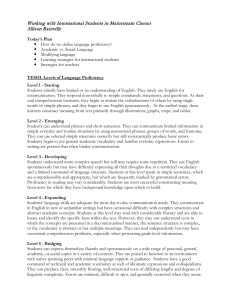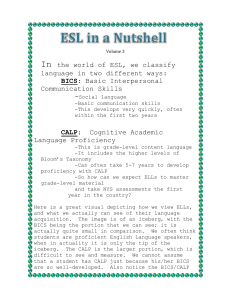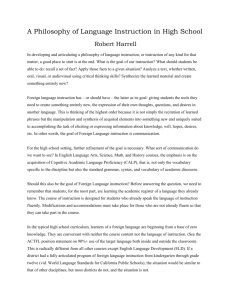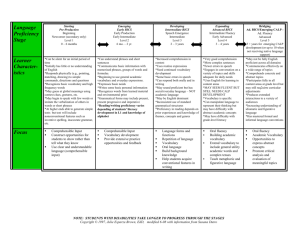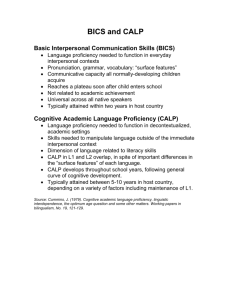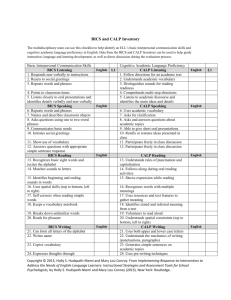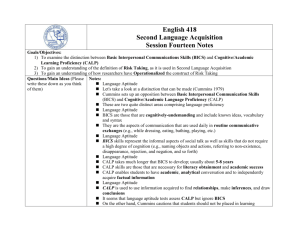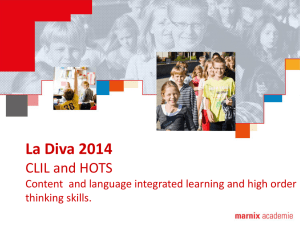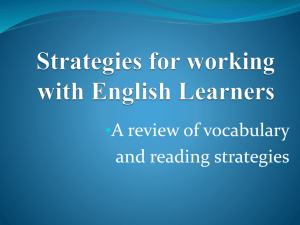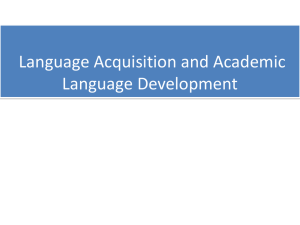BICS+CALP
advertisement
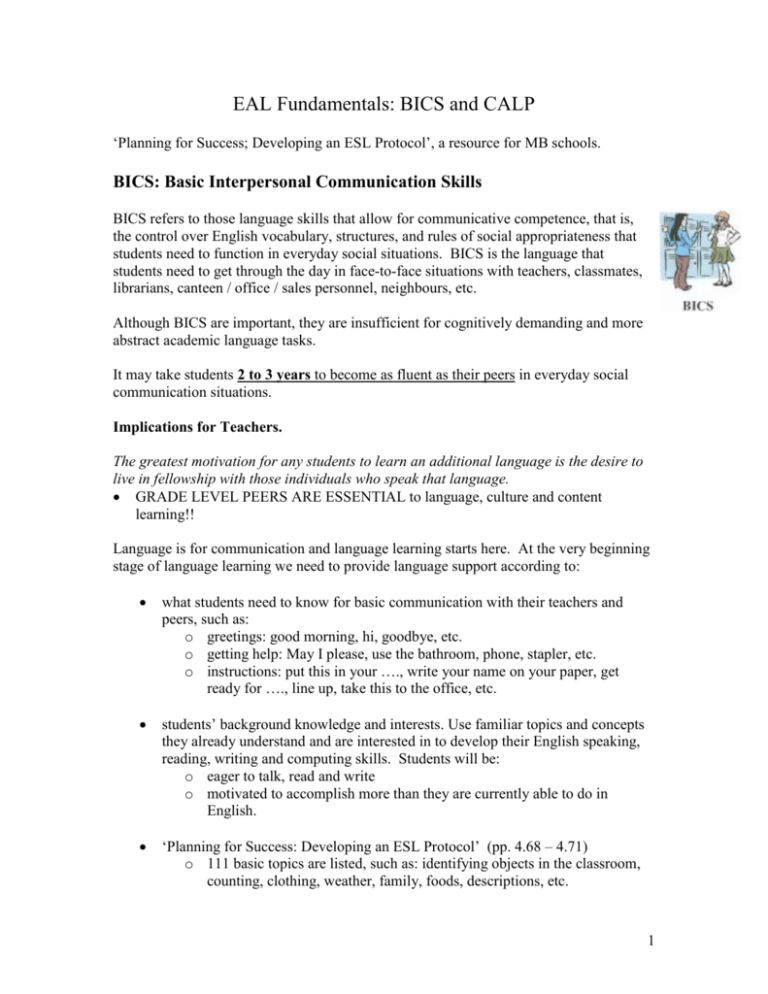
EAL Fundamentals: BICS and CALP ‘Planning for Success; Developing an ESL Protocol’, a resource for MB schools. BICS: Basic Interpersonal Communication Skills BICS refers to those language skills that allow for communicative competence, that is, the control over English vocabulary, structures, and rules of social appropriateness that students need to function in everyday social situations. BICS is the language that students need to get through the day in face-to-face situations with teachers, classmates, librarians, canteen / office / sales personnel, neighbours, etc. Although BICS are important, they are insufficient for cognitively demanding and more abstract academic language tasks. It may take students 2 to 3 years to become as fluent as their peers in everyday social communication situations. Implications for Teachers. The greatest motivation for any students to learn an additional language is the desire to live in fellowship with those individuals who speak that language. GRADE LEVEL PEERS ARE ESSENTIAL to language, culture and content learning!! Language is for communication and language learning starts here. At the very beginning stage of language learning we need to provide language support according to: what students need to know for basic communication with their teachers and peers, such as: o greetings: good morning, hi, goodbye, etc. o getting help: May I please, use the bathroom, phone, stapler, etc. o instructions: put this in your …., write your name on your paper, get ready for …., line up, take this to the office, etc. students’ background knowledge and interests. Use familiar topics and concepts they already understand and are interested in to develop their English speaking, reading, writing and computing skills. Students will be: o eager to talk, read and write o motivated to accomplish more than they are currently able to do in English. ‘Planning for Success: Developing an ESL Protocol’ (pp. 4.68 – 4.71) o 111 basic topics are listed, such as: identifying objects in the classroom, counting, clothing, weather, family, foods, descriptions, etc. 1 Essential Principles Students need an initial ‘silent period’ which may last days, weeks, months or semesters to build a listening (receptive) vocabulary. It is important that all teachers recognize and respect this stage. Language acquisition is gradual; based on receiving and understanding messages. Students learn to speak by speaking when ready! GRADE LEVEL PEERS ARE ESSENTIAL for learning and students’ motivation to learn!! Verbal production begins slowly. Expressive skills ‘lag behind’ receptive skills. Environment is INCLUSIVE: risk-free, pressure-free, accepting, cooperative, supportive ALL teachers strive to make written and spoken language comprehensible through: o Visuals: pictures, books & magazines with pictures, photos, objects, maps, charts, graphic organizers, drawings, role-playing, games, etc. o simplified language & texts, translations, summaries of texts by peers or E.A. o gestures, pantomimes, experiences, demonstrations, hands-on activities o samples, exemplars, models o peer helpers/partners, group work, lit circles, guided reading Adaptation strategies are used for assignments and assessment, such as: o allowing students to work with a partner o providing more time o reducing expectations of length and complexity of students output o reducing the language load by providing word banks, visuals, translation, etc. o allowing visual representations to demonstrate student learning o reading through the errors; respond and assess learning Errors are expected and necessary to learning. This is perhaps a disturbing concept for students conditioned to the need to be correct at all times. Praise for attempts, efforts and willingness to try. 2 CALP: Cognitive Academic Language Proficiency CALP refers to higher-order language skills that are essential for problem solving inferring, analyzing, synthesizing, and predicting. The acquisition of CALP, which is essential for academic success, is a more challenging and lengthy process than the acquisition of BICS. This language is used mainly in: books, assignments, discussions, lectures, etc. All students are expected to know many words and phrases that are NOT part of everyday face-to-face conversations. Furthermore, all students are expected to know vocabulary and phrases not used in everyday conversations at a very early age. For example: Winnie the Pooh declared…, Tigger exclaimed…, Eyore sighed…, etc. Some students may require seven to nine years to develop CALP to the level of their peers. Implications and Direction for Teachers Reading texts o Use simplified texts with illustrations for pre-literate and literate students as soon as possible in order to get to vocabulary and phrases (in context) that do not arise in normal conversations. o Teacher read-a-louds, reader theatre scripts, fiction and non-fiction texts should be used within a thematic approach that continues to be based on lots of visuals and talking to promote skills in both BICS as well as CALP. o Resources: library books, literacy lab sets, Reading Recovery texts, magazines, newspapers, Penguin Readers, Oxford Bookworms, simplified basic science, health and social studies texts from elementary classrooms o Encourage extensive reading at students’ level and interest Writing o Writing is where BICS (social language) and CALP (academic language) are demonstrated in the most formal and most difficult mode of communication. o Teachers need to quickly provide the appropriate vocabulary and phrases that students need to communicate their intended thoughts and ideas. o This is the most productive and useful context in which grammar instruction can occur, ‘at the point of need’. Student: “How you say….?” Teacher: “In English, it needs to sound like this, …….” 3
